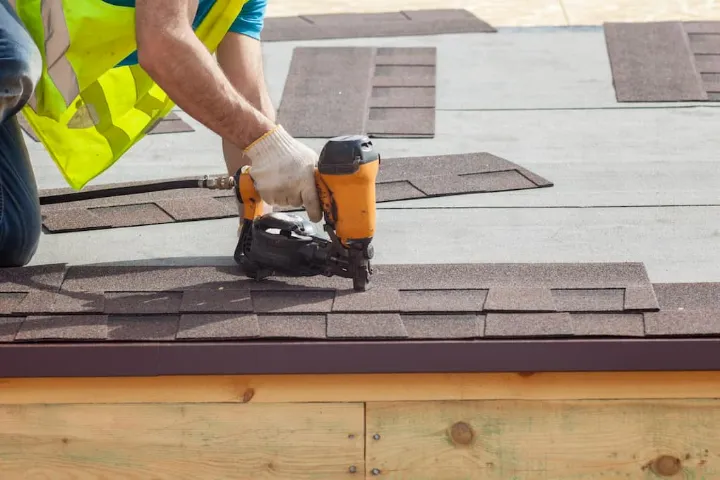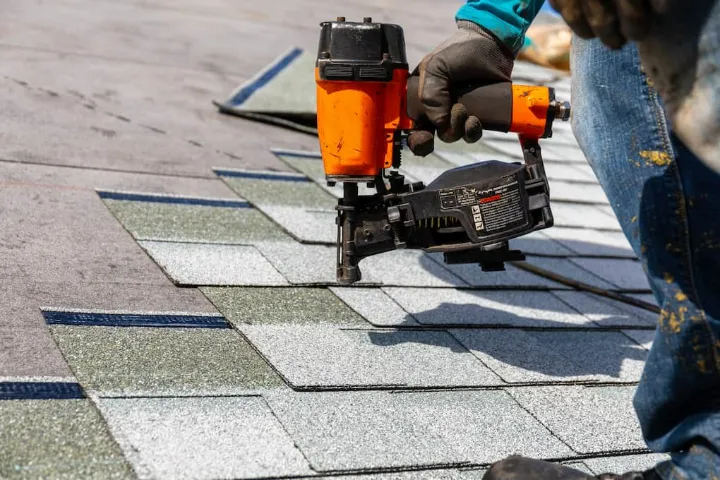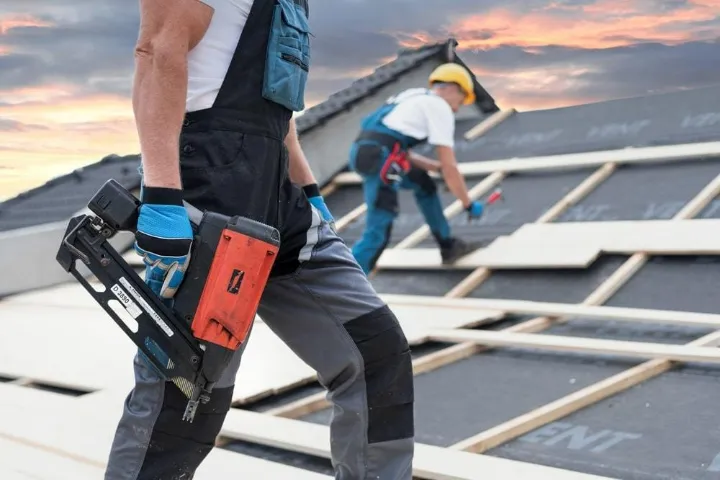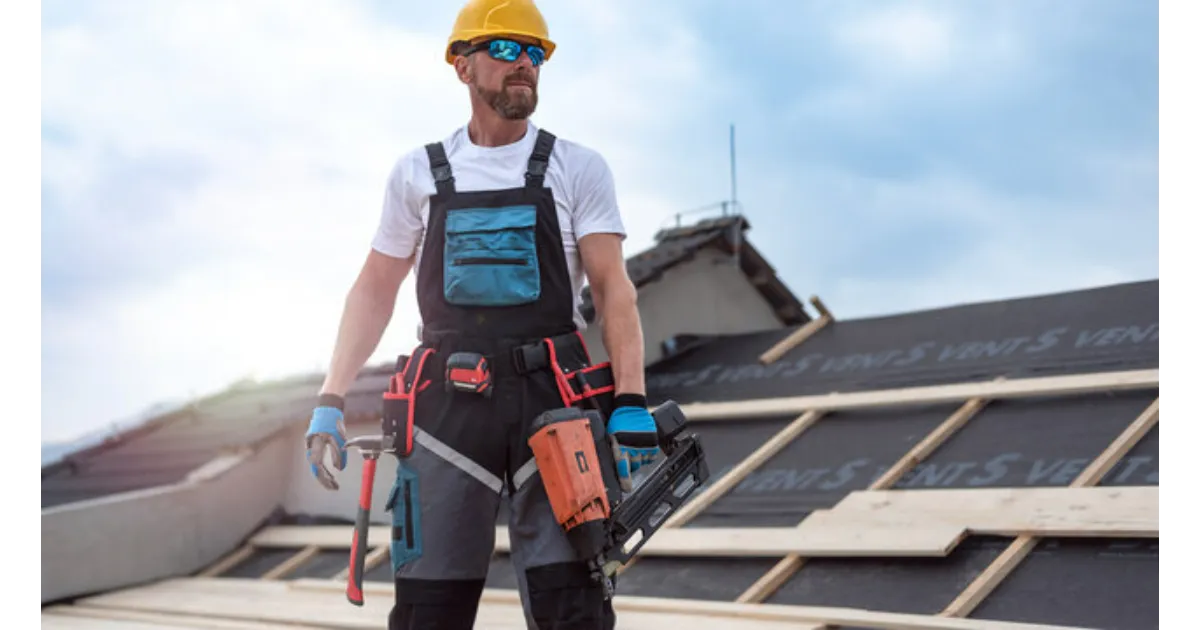Table of Contents
A Buyer’s Guide to Roofing Nailers
A nail gun, also referred to as a nailer, is a hand tool that is designed to drive a nail into various surfaces. Originally created to work on Howard Hughes’ “Spruce Goose,” the nailer debuted in the construction market in the early 1950’s.
Since that time, this tool has become a go-to tool for the carpentry and roofing industries. Nailers can be broken down into nailer types based on what they use for driving a nail:
- Air or pneumatic nail gun: Possibly the most common nailer, it is powered by compressed air
- Combustion nail gun: This type of nailer uses a gas like propane for power
- Electric nail gun: An electric motor powers this type of nailer
- Explosive-powered nail gun: Ignited powder creates a gas in these nailers
- Solenoid-powered nail gun: One or more coils are powered by a capacitor in these nailers and are sometimes called a coil gun.
These devices are fed fasteners that are gathered into strips or coils. Heavy-duty nailers used on concrete or steel may require loading individual fasteners by hand.
Nailers are built to handle a variety of fastener sizes, from small pin nails up to the large clipped and full head nails, or even six-inch spikes, used on many exterior structures.
Nailers Designed For Roofing

The best roofing nailers on the market are nailers that are designed specifically for roofing jobs. These nailers hold and fire fasteners in sizes that are used for holding insulation board, roofing shingles, and tar paper.
The best roofing nail gun models make use of coil nails. A coil of roofing nails allows a user to work for longer periods of time between reloads. Coil roofing nail guns are also designed for better weight distribution.
Product Reviews
The Best Lightweight Nail Gun – Bostitch RN46-1
No products found.
The RN46-1 is built with an aluminum body that helps to keep the tool’s weight down. It also provides adequate durability to ensure longevity.
There are carbide inserts on the nosepiece, an addition that should help to extend the life of this nailer. Additional guards and pads have been added to protect it against abrasion and other damage.
Bostitch designed this nail gun with a patented single-action side load canister that speeds up the loading process. It has an adjustable shingle guide that allows beginners and pros alike to properly space fasteners.
The quick-set depth guide is adjustable and allows you to set the depth that nails are driven. This tool can be fired with a contact trigger mode or sequentially.
Safety features include a lockout that helps to prevent dry firing the nailer when it is empty and also indicates when it is time to reload the magazine.
The trigger is easy to use as it provides little resistance. Because of this, make sure to keep your fingers off of the trigger when it is not in use.
Bostitch offers excellent customer service and support for the RN46-1 nailer. The product comes with a seven-year warranty on parts and labor.
They also offer online manual and parts ordering, and the manufacturer has a listing of several service centers that are located throughout the United States.
PROS
- This nailer is lightweight due to its magnesium body
- The user can adjust the depth of drive easily on this nail gun
- It works well with as little as 100 psi
CONS
- This product may occasionally double fire
- The rate of fire can cause this nailer to jam with excessive triggering
Most Accurate For Beginners – Hitachi NV45AB2
No products found.
This nailer is made from lightweight metals that protect it from standard use and wear. An interesting feature on this nailer is the pneumatic-powered feed mechanism. It is designed to help remove dirt and moisture from the nailer during use, but it can also require firing a few nails to get it up to speed in cold weather.
It uses a side loading magazine that is able to hold a variety of nail sizes. A nice feature is the magazine size, which can hold up to 120 nails per load. This will require less reloads during use.
The nailer fires by contact with its quick-driving feature, allowing the user to work quickly in large areas by firing when the nose makes contact with the surface. This quick-driving feature is not as advantageous in smaller spaces.
This nailer has the flexibility to work with the wide range of nail sizes that are used for roofing jobs. It is able to handle nails as small as 7/8-inch all the way to 1 3/4-inch.
Its open nose design aids with jam clearing and the depth setting for nail drives is tool-less. The magazine rests at a 16-degree angle that helps to provide balance, and the rubber grip is comfortable.
PROS
- This nail gun is well balanced for easy use with one hand
- It can handle an array of fastener sizes
- The magazine can hold up to 120 nails
CONS
- The sequential actuation option requires a trigger that’s sold separately
- It can operate sluggishly in cold weather until it warms up with use
Most Tangle-Free Nailer – Max CN445R3
No products found.
The Superroofer from Max is composed of various metals and plastics. This combination of materials should not compromise durability except perhaps with extended use in a professional setting.
It is surprisingly heavy for a nailer made with some plastic components.
The Max CN445R3 can be disassembled easily, allowing the operator to quickly tear down the tool for cleaning or other maintenance.
Its removable contact foot also aids with clean up. The manufacturer also offers different kits that can be purchased and added to the nailer to help perform a variety of different jobs, including vinyl work.
The trigger has a rapid-fire capacity that allows a user to drive more than one nail per second if they are experienced. It is also equipped with a trigger lock, a feature that will help prevent accidental firing.
The nose is magnetic and self-cleaning, which helps to prevent dirt or tar build-up. An adjustable depth control and shingle guide make this tool easy for novices to use.
Perhaps the most unique feature on this roofing nailer is the air hose fitting, which swivels.
This design element will help to keep the hose from buckling or tangling, something that can happen easily when reaching into areas with awkward angles.
PROS
- The rapid-fire trigger allows for quick nail driving in larger areas
- The nose is magnetic and can hold the last nail without issue
- This nail gun comes with a swiveling hose fitting
CONS
- The biggest drawback to this nail gun is that it is a bit heavy
- It has a short warranty of only one year
A Comfortable Nailer – Senco Roof Pro 455XP
No products found.
The Roof Pro from Senco is a straightforward design, made from metal and plastic. This combination still provides enough durability to allow the manufacturer to provide a healthy warranty on this tool.
Its no-frills design offers a profile that should not get in the way when nailing in those harder to reach places.
The tool’s longevity is also increased with the metal wear plate in the nail canister, where coils can wear them out. One design feature worth mentioning is the 360-degree exhaust that adjusts.
This allows the user to select the venting direction and is not found on most air powered roofing nailers. It is capable of driving most nails used for roofing jobs.
Another interior part that was added to reduce wear is the bi-metal driver blade. The area where this product stands out is its ergonomic add-ons. The design itself is comfortable and easy to hold.
The soft material used for the handles also helps to relieve hand fatigue. The design helps the nail gun to stay balanced when held, something that allows continuous use for long periods of time. It comes with a carrying case as well.
This product has a tendency to double or triple fire multiple times per magazine load. It will also fire a bent nail on occasion. These inconsistencies, along with its higher price tag, make this roofing nailer less desirable for professionals.
PROS
- This tool is covered by a five-year warranty
- The handle and trigger can accommodate smaller hands
CONS
- It has a higher price point for the features offered
- The nailer may be a bit inconsistent during use
An Inexpensive Entry Level Nailer – Grip-Rite GRTCS250
No products found.
This coil roofing nailer is made from metal and plastic. The metal parts are made from a magnesium alloy that offers decent durability and a low weight.
It is simple in design but still offers some useful features. The collation is rated as wire weld and it is activated by bump fire. It has a 360-degree tool exhaust that provides tool-free adjustment.
The canister is easy to load, which means less downtime on the roof. Grip-Rite provides a shingle placement guide that helps to keep rows straight, and the depth adjustment can be done without tools.
Carbide steel inserts help to extend the longevity of this nailer well past the warranty.
An interesting design element is the dual feed pawl system that helps to provide more consistent driving. A fast cycle rate allows this nail gun to fire as quickly as the user can bump it.
The manufacturer includes many extras with the nail gun. A rotating belt hook allows the user to free their hands without having to secure the nailer along the roof.
They provide a carry case as well as a pair of safety glasses. Tool oil and hex wrenches are included for maintenance. The extras also include a 1/4-inch male plug adaptor along with the manual.
PROS
- It is a lightweight nail gun
- This nailer has a low price point
- It includes a lot of extras
CONS
- It comes with a limited one-year warranty
- The nailer does not fire sequentially
Best Nailer for Parts and Service – Ridgid R175RNF
No products found.
This coil roofing nailer is made from magnesium alloys and plastics, and Ridgid has added extra protection. There are wear guards and skid plates that help to prevent abrasions.
The rubber molding that covers the parts of this nail gun is over-molded to provide extra protection by interlocking over the body. It includes carbide inserts and a dry-fire lockout that extends the life of the motor and the nosepiece.
Ridgid made sure to include features that help to provide accurate and clean drives with each nail. The straight drive feature keeps nails sitting flush, which can help to prevent damage to the shingle.
An anti-skid plate aids in keeping the nailer in place while in use. It also includes a magnetic nail holder that positions each nail properly.
The EZ load feature makes loading the nails in the magazine easy and fast. A selector allows the user to select either bump or sequential firing to offer more control in various locations on the roof.
The trigger operates smoothly with each pull and the recoil feels standard. It includes a removable shingle guide that can be adjusted without tools. Finally, the company offers a three-year warranty and free replacement and service on some parts for life.
PROS
- Free parts and lifetime service on some components offered after registration
- Straight drive feature helps nails sit flush with the roofing materials
- The diffuser automatically directs the exhaust away from the operator
CONS
- The bump fire mode is less sensitive than on other nailers
- Its rubber handle molding makes service access more difficult
An Inexpensive Senco Alternative- Senco ROOFPRO 455XP
No products found.
This offering from Senco shares many of the characteristics found in the Pro 455XP reviewed above.
One notable difference is the aluminum housing and cap, which should provide more durability than a magnesium body would. The steel wear plate adds to its durability by protecting against abrasion against shingle materials.
It has an adjustable nail canister that can accommodate an entire range of round head roofing nails. This range can include nails from 3/4 to 1 3/4-inches without issue.
The exhaust is adjustable and allows the user to point it away from their body. This nailer should hold its look, as the paint finish is highly durable.
The tool comes with a connector, oil, and the wrenches needed to operate and service it, and everything comes in a carry case that provides easy transportation.
As with other Senco products, this roofing nailer is covered by a five-year warranty on parts. It has a simple design and could be ideal for a homeowner looking to do their own roofing.
This device does have a tendency to fire doubles or triples at a rate of three or four times per canister load, and it also fires bent nails several times per load.
These inconsistencies make it less suitable for a commercial roofer who needs reliability and speed from their roofing nailer.
PROS
- It has a slightly better price point than the previously reviewed Senco roof nailer
- A thinner handle makes this nailer easy for almost anybody to use
CONS
- This nail gun suffers from the same inconsistency found in the Pro 455XP
- The grip is not as comfortable as other Senco nailer handles
The Benefits of Using a Roofing Nailer

A nailer is more precise
A nailer can drive a roofing nail more accurately than a conventional hammer can. Inexperience can cause the user to drive a fastener outside of the desired location on a shingle. This may cause leaks as well as a void on the material warranty. A roofing nailer allows the user to place a fastener in the proper location on a shingle each time.
A nailer requires less work
These devices are easier to use when compared to a hammer; the user simply places the nail gun at the desired location and pulls the trigger. Conventional hammers wear out the user’s arms, back, and shoulders quickly, whereas the best roofing nail gun models are ergonomically designed, making them more comfortable to use for extended periods of time.
A nailer saves time
Traditional nailing requires the user to align the fastener, hold it in place, and to hammer it multiple times to drive it. The roof nail gun only needs to be aligned before driving the nail with a pull of the trigger. A nailer saves the user a lot of time, especially if they are not a roofer by trade.
Things to Look for in a Roofing Nailer

There are a few things to look for when determining the best roofing nailer for you. Choosing the type of nailer is the first consideration.
- Air nailers are very common, but keep in mind that they require an air hose reel that can get in the way or pose a tripping hazard on the roof. These types of nailers are also noisy as they require an air compressor to operate.
- An electric nailer is a less noisy option but is heavier as this type requires a motor for power. They also make use of an electrical cord that poses the same difficulties as an air hose.
- A rechargeable nailer eliminates the problems with air hoses and electrical cords but requires batteries that need to be recharged or extra batteries to complete most roofing jobs.
- Balance and weight are the next considerations. Most roofing jobs require a user to operate a nailer for long periods of time. A balanced nailer is easier to hold, and the weight of the nailer should be easy to handle. Nailing speed is another consideration, and the nailer should have a rate of fire of at least one nail per second.
Other considerations include nail size, magazine design, and the comfort of the grip.
Conclusion
All of the roofing or brad nailers reviewed above are capable of providing the user with a tool that will save them energy and time.
While they all share a similar rating in some categories, each of these air powered tools provides unique features that makes them stand out. Their weight and load capacity make them ideal nailers for your roofing projects.
Unlike other roofing nailer reviews, this article hopes to encourage you to look further into the nail guns reviewed above to decide which one will fit your needs. If you have found a good match, that means we have nailed it!

